Table of Contents
Table of Contents
Network performance is the lifeblood of modern enterprises, underpinning everything from communication to data transfer, and even the smooth functioning of mission-critical applications. A single glitch can lead to downtime, productivity losses, and dissatisfied users. This is where synthetic testing steps into the spotlight as an invaluable tool for ensuring your network's reliability and resilience.
Welcome to our deep dive into the world of Synthetic Network Testing, where we'll unravel the mysteries and unveil the transformative potential of this essential practice. Whether you're a seasoned network administrator striving for impeccable performance or a business IT professional tasked with maintaining a seamless digital ecosystem, this blog post is your gateway to understanding how synthetic testing can be your secret weapon in the quest for network excellence.
We'll explore what synthetic testing is, why it matters more than ever in today's business landscape, and how it empowers IT pros and network admins to proactively manage network performance and deliver the best possible user experience. So, fasten your seatbelts as we embark on this journey into the world of Synthetic Network Testing, where performance optimization meets business success. Let's get started!
First, let’s start with the basics.
Synthetic testing in networking, also known as synthetic network testing, is a methodology used to evaluate and monitor the performance, reliability, and responsiveness of a computer network, applications, or services by generating simulated traffic and measuring how the network and its components respond to that traffic.
This synthetic traffic is artificially created, as opposed to using real user-generated traffic, to systematically assess network capabilities and identify potential issues or bottlenecks.
Synthetic testing in networking can be used for a variety of different aspects of network testing:
- Simulation of User Behaviour: Synthetic tests simulate the behaviour of network users, applications, or devices by sending predefined traffic patterns or data packets across the network. These tests mimic typical user interactions, such as web browsing, file transfers, video streaming, or VoIP calls.
- Performance Benchmarking: By generating controlled traffic, synthetic testing helps establish baseline performance metrics for the network, such as latency, bandwidth utilization, network utilization, packet loss, and throughput. This data serves as a reference point for monitoring and identifying deviations from expected performance levels.
- Proactive Issue Identification: Synthetic testing allows network administrators and IT professionals to proactively identify and address potential issues before they impact real users. It can reveal problems like slow response times, network congestion, or application performance degradation.
- Capacity Planning: Network administrators use synthetic testing to determine whether the current network infrastructure can handle projected increases in traffic, helping them make informed decisions about scaling resources or optimizing network configurations.
- Validation of Service Level Agreements (SLAs): Synthetic tests can be employed to validate that network service providers are meeting their SLAs by continuously monitoring and reporting on network performance parameters.
- Change Management: Before implementing changes to the network, such as adding new hardware, updating configurations, or rolling out software updates, synthetic testing can be used to assess the potential impact of these changes and ensure they do not degrade network performance.
- Troubleshooting: When network issues arise, synthetic testing can be a valuable diagnostic tool. By comparing the results of synthetic tests during normal operation with results during problematic periods, network administrators can pinpoint the source of performance problems.
In summary, synthetic testing in networking is a proactive and systematic approach to evaluating network performance by generating controlled, simulated traffic. It plays a crucial role in maintaining a reliable and responsive network infrastructure, ensuring that businesses can meet the demands of their users and applications while minimizing downtime and disruptions.
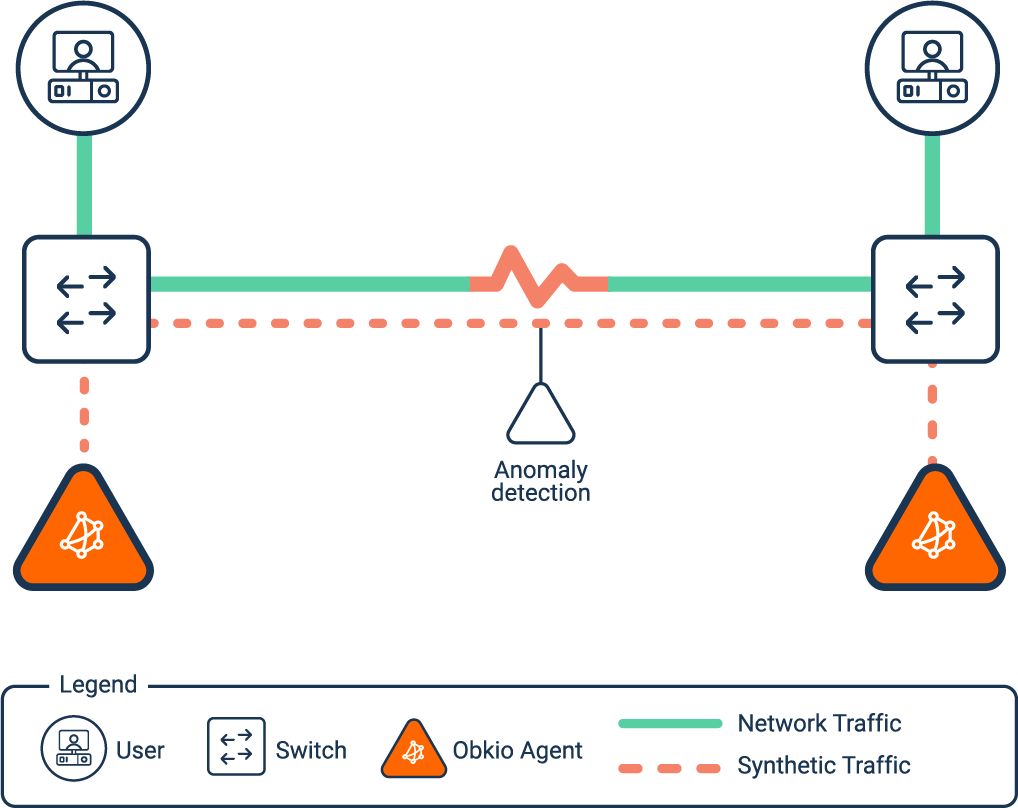

Are you ready to take your network performance monitoring to the next level? Look no further than Obkio, your trusted partner in the world of synthetic monitoring.
Obkio's Synthetic Network Monitoring tool empowers businesses and IT professionals with the tools they need to monitor end-to-end network performance for all network types, to ensure network excellence and deliver an unparalleled user experience.

Why Choose Obkio for Synthetic Testing:
- End-to-End Network Testing: Obkio's synthetic tests provide you with unparalleled precision and control over your network performance assessments. Monitoring Agents are deployed in key network locations and continuously exchange synthetic traffic to mimic real-world user interactions to identify bottlenecks and issues before they impact your users.
- Real-time Insights: Stay ahead of network problems with real-time monitoring and immediate alerts. Obkio's dashboard offers a comprehensive view of your network's health, so you can proactively address issues as they arise.
- Easy Setup: Obkio's user-friendly interface and straightforward setup make it a breeze to get started with synthetic network testing. No complex configurations or extensive training is required; you'll be up and running in just 10 minutes.
- Built For All Networks: Whether you're managing a small network or a global enterprise infrastructure, Obkio scales to meet your needs. Test performance across multiple locations and devices effortlessly.
- Actionable Data: Obkio not only identifies issues but also provides actionable insights to help you optimize your network. Make informed decisions based on data-driven recommendations.
Don't wait for network problems to disrupt your business. Take control with Obkio's synthetic monitoring and ensure your network is always at its best.**
Ready to experience the power of Obkio for yourself? Get started today and see the difference synthetic testing can make in your network performance. Click the button below to begin your journey towards network excellence:

In the realm of network performance monitoring, two distinct methodologies take center stage: synthetic testing and real-user testing. While both are essential tools in the arsenal of network administrators and IT professionals, they serve markedly different purposes and offer unique insights into the world of network performance.
In this section, we'll delve deep into the contrasting characteristics of these two approaches, shedding light on the fundamental distinctions that set them apart. Understanding the nuances of synthetic testing and real user testing is not only crucial for optimizing network performance but also for ensuring seamless user experiences.
- Synthetic Testing: Synthetic testing generates artificial traffic using predefined test scripts, or Agents exchanging synthetic traffic. This traffic is created by automated tools and does not represent actual user interactions. It aims to simulate typical network activities to evaluate network performance.
- Real User Testing: Real user testing relies on the actual traffic generated by end-users, employees, or customers using the network and its services. This traffic reflects the diversity and unpredictability of genuine user behaviour.
- Synthetic Testing: Synthetic tests provide a high degree of control and consistency because they use predefined test cases. This allows for systematic and repeatable testing, making it easier to pinpoint specific issues and track changes in performance over time. It also allows for network monitoring in locations, or during times, when no real traffic is available.
- Real User Testing: Real user traffic is inherently variable and can be influenced by factors such as user location, device type, and application usage patterns. This variability can make it challenging to isolate and diagnose specific network problems.
- Synthetic Testing: Synthetic tests are proactive in nature. They allow network administrators to proactively monitor network performance, identify potential issues, and take corrective actions before users experience problems. This proactive approach can prevent downtime and user frustration.
- Real User Testing: Real user testing is reactive because it relies on monitoring actual user experiences. Network administrators may only become aware of performance issues after users have already encountered them, potentially resulting in service disruptions and user dissatisfaction.
- Synthetic Testing: Synthetic tests can be run consistently in controlled testing environments, making it easier to isolate variables and measure the impact of changes to the network or applications.
- Real User Testing: Real user testing occurs in diverse and often uncontrolled environments, making it challenging to attribute performance issues to specific network components or configurations.
- Synthetic Testing: Synthetic tests can be scaled up or down as needed to simulate different levels of traffic and test various aspects of the network. This scalability allows for capacity planning and stress testing.
- Real User Testing: Real user traffic depends on the number of actual users and their activities, making it less predictable and controllable for capacity planning purposes.
- Isolation of Network Components:
- Synthetic Testing: Synthetic tests can isolate and focus on specific network components, such as routers, switches, or servers, to identify performance bottlenecks or failures.
- Real User Testing: Real user traffic often traverses multiple network components simultaneously, making it challenging to pinpoint the exact source of performance issues.
In summary, synthetic testing and real user testing serve distinct purposes in network management. While synthetic testing offers control, consistency, and proactive monitoring, real user testing provides insights into how actual users experience the network.
Discover the differences, benefits, and implementation strategies of active network monitoring vs passive network monitoring.
Learn more

Let's now delve into the details of synthetic testing. No need to be intimidated; it's simpler than it might sound. Essentially, synthetic testing operates by mimicking user actions with network resources, evaluating performance, and detecting potential problems.
Synthetic monitoring revolves around simulating user interactions with network resources to assess performance and pinpoint potential issues. To grasp the concept better, here's how it operates:
- Identify Your Use Case: First, IT teams need to define the use cases that they want to test. These scenarios are typically based on typical user behaviour on the network, such as logging in, browsing web pages, or streaming videos. You can also use synthetic testing to test network performance as a whole, identify network issues, and optimize network performance.
- Finding the Right Synthetic Testing Tool: Synthetic Testing tools are quickly overtaking Passive or Packet Capture monitoring tools in the Network Monitoring space - and for good reason! With so many tools available on the market, there's a variety of options to choose from.
- Deploying Monitoring Scripts or Agents: Using a synthetic testing solution like Obkio, IT teams create and then simulate user traffic in the network. Some synthetic testing tools use test scripts that send requests to network resources and simulate user interactions. Tools like Obkio are even easier to use and utilize software called Network Monitoring Agents, which are deployed at key network locations and exchange synthetic traffic to measure network metrics.
- Generating Traffic: Once the Monitoring Agents or test scripts are set up, synthetic testing generates traffic by simulating user interactions. This traffic is generated from various locations, including cloud-based servers and on-premise hardware.
- Collecting Data: Synthetic monitoring collects data on network performance based on the test scripts and generated traffic. This data includes metrics such as network response time, network availability, and error rates. It provides IT teams with a comprehensive view of network performance, even in situations where there is no real user traffic.
- Analyzing Results: IT teams can then analyze the results of synthetic monitoring to identify issues and optimize network performance. Synthetic monitoring provides real-time network monitoring alerts when issues are detected, allowing IT teams to take proactive steps to address them.
Overall, synthetic testing provides a proactive technique for IT teams to test network performance and identify issues. By simulating user interactions and generating traffic, synthetic testing offers a comprehensive view of network performance, even in situations where there is no real user traffic.
With the help of a synthetic monitoring solution like Obkio, IT teams can proactively improve network performance and ensure users get only the best network performance.
Let's now apply synthetic testing in practice! Thanks to Obkio's cloud-based solution, embarking on synthetic testing has never been more straightforward. With Obkio's assistance, you'll have the tools you need to enhance your network performance with confidence. So, get ready to roll up your sleeves and let's start optimizing!
Synthetic Network Testing is generally a feature of Network Monitoring tools like Obkio. Obkio is a cloud-based synthetic network monitoring solution that allows IT teams to simulate user behaviour with Monitoring Agents and synthetic UDP traffic to test network performance and proactively detect network issues.
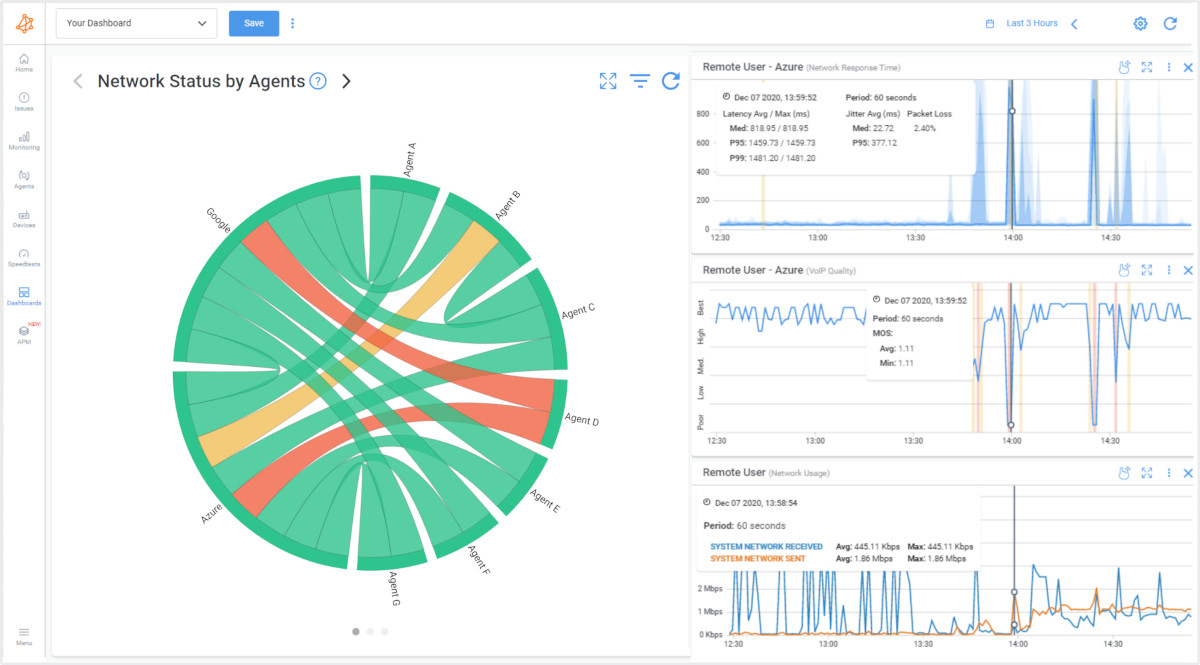
- Obkio uses synthetic traffic (UDP Packets) to simulate real-user behaviour and monitor every end of your network, from WAN to LAN.
- The synthetic traffic is exchanged by Monitoring Agents, deployed at key network locations like remote offices, data centers, user workstations, and even over the Internet.
- The Monitoring Agents exchange synthetic traffic every 500ms to continuously monitor network performance and measure network metrics.
Synthetic testing relies on the utilization of agents or specialized hardware and software designed to replicate the performance of real users within a network or application environment. In the context of Obkio, these agents are referred to as [Network Monitoring Agents]/monitoring-agent/), which are proprietary software tools developed to assess network and application performance, as well as their availability.
To leverage this capability effectively, you can strategically deploy Monitoring Agents at critical network locations such as headquarters, branch offices, and cloud environments. These agents can be strategically positioned, whether near the firewall to assess ISP performance (WAN) or at the far end of the LAN network, providing a comprehensive end-to-end performance monitoring solution.
These Agents then engage in the exchange of synthetic traffic among themselves, effectively measuring network and application performance as if they were genuine users.
- Software or Hardware Agents: Deploy these Agents in remote offices, branch offices or data centers to monitor network performance locally. The Agents can be deployed on a variety of operating systems (macOS, Windows, Linux, VMWare), or can be purchased as hardware.
- Public Monitoring Agents: These are deployed over the Internet and managed by Obkio. They compare performance up to the Internet and quickly identify if network issues are global or specific to one destination. You can use an AWS or Google Cloud Agent.
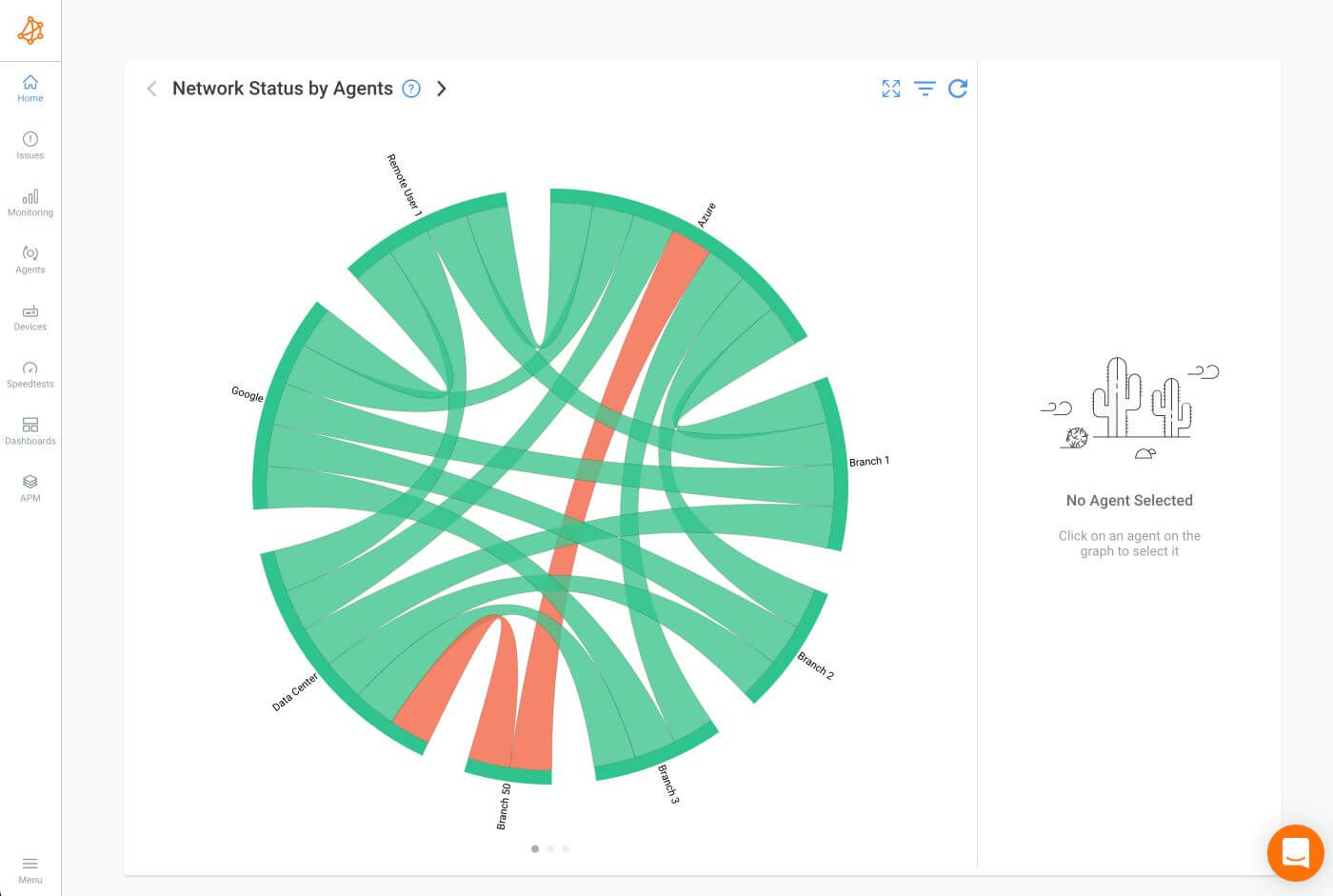
Synthetic network testing can be used to monitor various parts of your network infrastructure to assess performance, reliability, and responsiveness. Here are some key parts of your network that you can effectively monitor using synthetic network testing:
- WAN (Wide Area Network): Monitor the performance of your WAN connections, including leased lines, MPLS, VPNs, and internet links, to ensure consistent connectivity and low latency.
- LAN (Local Area Network): Assess the performance of your local area network, including switches, routers, and cabling, to identify congestion, packet loss, or network bottlenecks.
- Wireless Networks: Evaluate the quality and coverage of your wireless networks, such as Wi-Fi, by measuring signal strength, throughput, and latency.
- Data Centers: Monitor the performance of data center networks, including servers, storage devices, load balancers, and switches, to ensure optimal data processing and access.
- Cloud Services: Assess the performance of cloud-based services and applications, such as those hosted on AWS, Azure, or Google Cloud, to ensure reliable access for users.
- Remote Offices: Monitor network performance at remote office locations to ensure seamless connectivity for remote workers and branch offices.
- VoIP (Voice over IP): Evaluate the quality of voice and video communication services by monitoring call quality, jitter, latency, and packet loss.
- Applications: Test the performance of critical applications, such as web services, email servers, and database servers, to ensure they meet performance SLAs.
- Network Paths: Analyze the performance of specific network paths or routes to identify potential bottlenecks or areas of congestion.
- Cloud-Based Applications: Assess the performance of SaaS (Software as a Service) applications, such as Office 365 or [Salesforce(/blog/best-practices-salesforce-performance/), to ensure users have a seamless experience.
- Load Balancers: Evaluate load balancer performance by simulating traffic and observing how it distributes requests across servers.
- Internet Service Providers (ISPs): Monitor the performance of your internet service providers to verify that they meet their service level agreements (SLAs).
- Firewalls and Security Appliances: Test the security appliances and firewalls in your network to ensure they effectively filter traffic without causing performance degradation.
- DNS (Domain Name System): Monitor DNS resolution times and ensure domain name resolution is swift and reliable.
- Network Segments: Assess specific network segments or VLANs to identify issues related to segmentation or isolation.
- Third-Party Services: Monitor the performance of third-party services and APIs that your applications rely on for functionality.
- Multi-Cloud Environments: Evaluate the performance of network connections and services across multiple cloud providers in hybrid or multi-cloud environments.
Once deployed, Obkio’s Agents exchange automated, synthetic traffic (in the form of UDP packets) to mimic a user’s behaviour throughout your network, Internet and key applications and services. Obkio's Synthetic traffic is light, non-intrusive, and secure and allows you to test network performance even when there are no users present.
Obkio's synthetic testing offers a distinct advantage by allowing you to monitor aspects of your network or application that may lack genuine user traffic or experience low user activity. This capability ensures a comprehensive end-to-end perspective of your network's performance.
In the context of the growing trend of remote work, numerous businesses have a significant portion of their workforce operating from home. In situations where local IT support may not be readily available to address network issues in remote offices, employees can take the initiative by setting up monitoring agents within their home offices. These agents then monitor network performance between their home office and the company's central headquarters, without generating substantial traffic loads.
This proactive approach enables the IT team to gain visibility into network issues should they arise at remote locations. The network data collected through synthetic traffic serves as a valuable troubleshooting resource. With a solution like Obkio, all this data can be conveniently accessed and analyzed through a centralized dashboard.
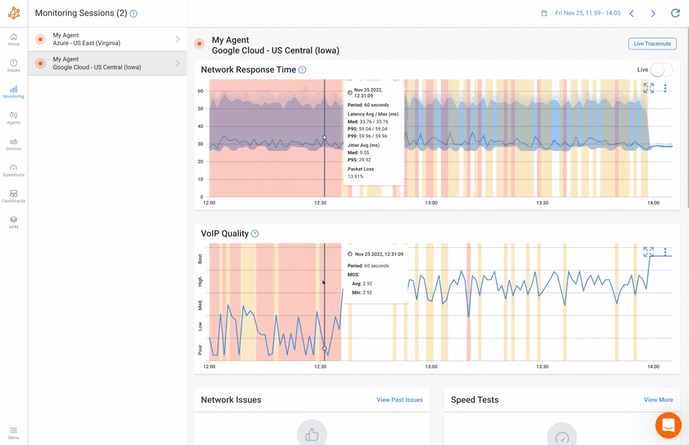

Obkio's Synthetic Monitoring tool offers a versatile application beyond network and application performance monitoring. It can also serve as a valuable resource for evaluating the performance of your network devices. Instead of solely focusing on network and application layers, synthetic testing can be extended to monitor and assess the efficiency of your network devices.
In this context, synthetic tests simulate user traffic using these devices, effectively gauging their performance and identifying any potential resource-related issues. By doing so, you gain a comprehensive view of not only your network and applications but also the vital infrastructure components that support them. This proactive approach ensures that your network devices operate optimally, minimizing the risk of bottlenecks or resource constraints that could impact overall network performance
Just use Obkio's Device Monitoring feature and add the network devices you want to monitor. You can test a wide range of network devices and components using synthetic network testing, such as:
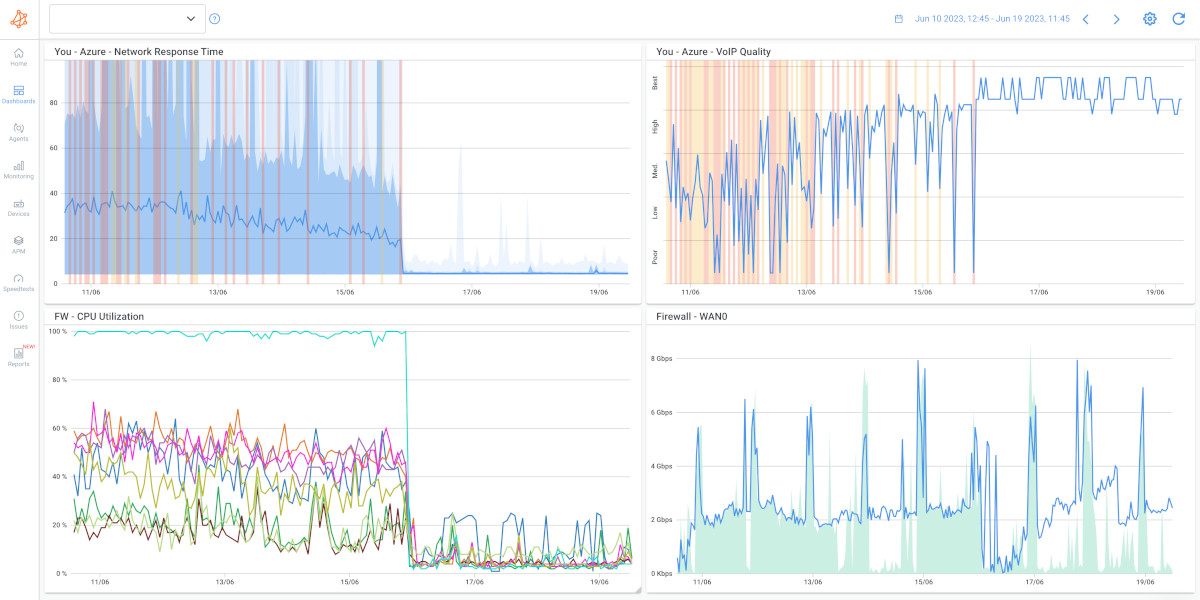
- Routers: Test the routing capabilities, traffic management, and packet forwarding performance of routers in your network.
- Switches: Evaluate the switching speed, VLAN configuration, and quality of service (QoS) settings on switches.
- Firewalls: Assess the security and throughput of firewall devices, ensuring they efficiently filter traffic while not causing network congestion.
- Load Balancers: Verify the load balancing functionality by simulating traffic and monitoring how the load balancer distributes requests across servers.
- Wireless Access Points (APs): Evaluate the coverage, signal strength, and performance of wireless access points to ensure optimal Wi-Fi connectivity.
- Servers: Test server response times, resource utilization, and the capacity to handle simultaneous connections.
- Storage Devices: Assess the performance and availability of network-attached storage (NAS) or storage area network (SAN) devices.
- VoIP Phones: Simulate voice traffic to monitor call quality, latency, and jitter on VoIP phones.
- Printers and Scanners: Ensure that networked printers and scanners are responsive and can handle print or scan requests efficiently.
- Load Generators: Use load-generating devices to simulate high traffic loads, stressing network components to assess their performance under heavy use.
- Network Interfaces: Test individual network interfaces to check for errors, congestion, and throughput capabilities.
- Virtual Machines (VMs):** Assess the performance of virtual machines, including CPU usage, memory, and network I/O, to ensure optimal virtualization.
- Gateways: Evaluate the functionality of gateways, such as protocol translation or security gateways, by simulating traffic flows.
- Modems and DSLAMs: Monitor the performance and connectivity of modems and digital subscriber line access multiplexers (DSLAMs) for broadband services.
- Load Balancer Health Probes: Verify the effectiveness of health checks and failover mechanisms in load balancers.
By using synthetic network testing to assess these devices, you can proactively identify performance issues, optimize configurations, and maintain a robust and reliable network infrastructure.
Once you’ve deployed all your Agents and added the network devices you want to test, Obkio’s Agents will begin exchanging synthetic traffic to measure different network metrics that are key to understanding network performance and uncovering network problems.
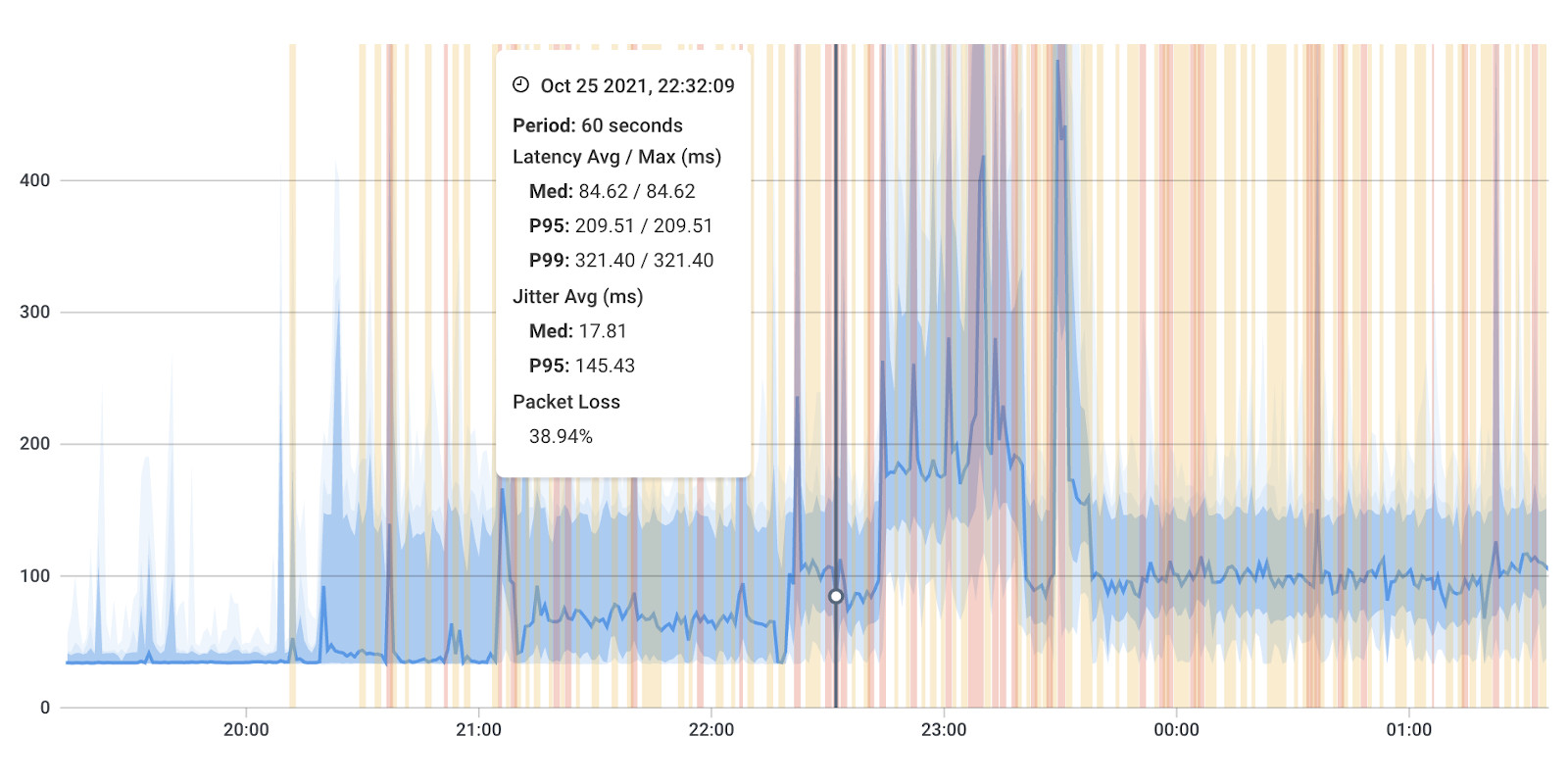
Every 500 ms, Obkio sends UDP packets between the Agents to measure network metrics such as:
- Latency: Latency is the amount of time it takes for a packet of data to travel from one point in a network to another. It's often measured in milliseconds (ms) and can be affected by factors such as network congestion, distance between devices, and processing delays.
- Jitter: Jitter is the variation in the delay between packets of data as they travel through a network. It's also measured in milliseconds (ms) and can cause disruptions in the quality of real-time communications like VoIP (voice over internet protocol) or video conferencing.
- Packet Loss: Packet loss occurs when packets of data fail to reach their intended destination. This can happen for a variety of reasons, such as network congestion or faulty network equipment. Packet loss can lead to degraded performance in real-time applications like VoIP or video streaming.
- Packet duplication: Packet duplication occurs when multiple copies of the same packet are received at the destination. This can happen due to network errors or equipment failures and can lead to network congestion and reduced performance.
- Packet reordering: Packet reordering occurs when packets arrive at the destination out of order. This can happen when different packets take different routes through the network, and can cause disruptions in real-time applications like VoIP or video conferencing.
- VoIP Quality: VoIP quality is a measure of the overall performance of a voice over internet protocol (VoIP) system. It can be affected by factors such as latency, jitter, packet loss, and network congestion, among others. VoIP quality is typically measured using a variety of metrics, including MOS (mean opinion score), R-factor, and packet loss rate. A high-quality VoIP system should have low latency, low jitter, minimal packet loss, and good overall call quality.
- And more!
Measuring these network metrics allows you to quickly identify the earliest signs of performance degradation in your network, which may be a sign of live, past or intermittent network problems.
The most rewarding aspect of synthetic testing lies in its ability to proactively uncover network issues before they disrupt your users. This involves using synthetic traffic to detect and address network problems long before they manifest for real users.
With Obkio's synthetic testing capabilities, your IT teams can simulate user interactions with network services, applications, and devices, generating traffic that faithfully mimics real user behaviour. In doing so, synthetic monitoring provides a holistic perspective on network performance, even in scenarios with minimal or no real user traffic.
Leveraging the insights provided by Obkio's application, IT teams gain the power to proactively identify and troubleshoot issues like sluggish application performance, network congestion, network overload, or server downtime. By replicating user interactions with these services, synthetic testing excels at pinpointing potential network bottlenecks and network infrastructure problems, allowing IT teams to rectify them before they impact genuine users.
For Example: Consider the application of synthetic testing in detecting issues with website performance, such as slow page loading or error messages. By simulating user interactions with the website, synthetic testing can swiftly flag potential issues within the website's infrastructure, such as server glitches or network congestion. Armed with this information, IT teams can promptly address and resolve these concerns, ensuring a seamless user experience.

In the intricate landscape of network management, the significance of synthetic testing becomes abundantly clear to business IT professionals and network administrators. This section unpacks the core reasons behind the growing importance of synthetic testing in their roles, delving into critical aspects such as network reliability, the financial impact of downtime, and the undeniable benefits of proactive monitoring.
By understanding the criticality of network reliability, the substantial costs associated with downtime, and the advantages of staying one step ahead through proactive monitoring, IT professionals and network administrators can unlock the full potential of synthetic testing as a strategic tool in their network management arsenal.
In today's digital age, network reliability is paramount for businesses of all sizes and industries. Reliable networks are the backbone of operations, enabling seamless communication, data access, and application performance. Here's why it's critical:
- Business Continuity: Network reliability ensures that employees can work without interruptions. Downtime due to network issues can disrupt productivity, leading to missed opportunities and revenue losses.
- Customer Satisfaction: Businesses rely on networks to deliver services and products to customers. If network performance is unreliable, it can result in dissatisfied customers who may take their business elsewhere.
- Competitive Edge: In a competitive market, businesses that can consistently deliver reliable services and applications gain a competitive advantage. Unreliable networks can lead to a loss of market share.
- Data Security: Reliable networks are essential for maintaining data security. Network disruptions can expose vulnerabilities and increase the risk of security breaches.
Network downtime can be costly in more ways than one. Understanding the financial impact of downtime underscores the importance of proactive monitoring and synthetic testing:
- Revenue Loss: Downtime can directly impact revenue. E-commerce sites, for example, lose sales with every minute of unavailability. Manufacturing and logistics companies may face delays and penalties due to disrupted supply chains.
- Operational Costs: Downtime results in additional operational costs, including overtime pay for IT staff, emergency equipment repairs, and potential legal fees in case of contractual breaches.
- Reputation Damage: Extended downtime can damage a business's reputation, leading to customer attrition and decreased trust among stakeholders.
- Data Loss:** Network disruptions or network disconnections can result in data loss or corruption, which may require costly data recovery efforts.
Proactive network monitoring, facilitated by synthetic testing, offers several advantages that can help mitigate the risks associated with network downtime:
- Issue Identification: Proactive monitoring allows IT teams to identify and address network issues before they impact users. This proactive approach prevents downtime and minimizes user frustration.
- Resource Optimization: By continually monitoring network performance, IT professionals can optimize resource allocation, ensuring that network capacity and infrastructure meet current and future demands.
- SLA Compliance Proactive monitoring helps organizations meet service level agreements (SLAs) with customers and service providers by ensuring that performance targets in service or Internet SLAs are consistently met.
- Reduced Downtime: When issues are identified and addressed proactively, downtime incidents are less frequent and shorter in duration, reducing their impact on operations.
- Strategic Decision-Making: The data collected through synthetic testing and proactive monitoring provides valuable insights for strategic decision-making. IT professionals can make informed choices about infrastructure upgrades, network architecture changes, and technology investments.
In summary, synthetic testing matters for business IT professionals and network administrators because it is crucial for maintaining network reliability, minimizing the costs of downtime, and reaping the benefits of proactive monitoring. A proactive approach to network management not only enhances business continuity but also contributes to long-term success and competitiveness in today's interconnected world.
In the world of network monitoring and performance optimization, understanding the diverse range of synthetic tests is akin to having a versatile toolkit at your disposal. These tests serve as the eyes and ears of network administrators and IT professionals, allowing them to assess and fine-tune their networks with precision.
In this section, we'll explore the various types of synthetic tests, each designed to address specific aspects of network performance and reliability. From the simplicity of ICMP tests to the complexity of customized application assessments, these tests provide critical insights that empower network professionals to proactively manage and enhance their network infrastructure.
Join us as we embark on this journey through the different facets of synthetic testing, uncovering the unique capabilities and applications of each test type. Whether you're striving for seamless VoIP communication, uninterrupted video streaming, or the swift resolution of DNS queries, these tests offer the tools needed to ensure optimal network performance.
This technique may sound familiar to you because it’s the one we’ve already covered in this article! When you’re looking to leverage synthetic testing (or synthetic network testing, more specifically), to continuously monitor and test your network performance, this is the simplest and most detailed method.
Using continuous UDP traffic with a Network Monitoring tool like Obkio, gives you 360-degree visibility of your network at all times, so you can identify and troubleshoot network issues, no matter where they’re coming from.
- UDP (User Datagram Protocol) Testing: Synthetic monitoring with UDP traffic involves sending UDP packets to assess network performance. UDP testing is useful for assessing real-time applications like VoIP or video streaming, where delay is critical.
- Network Monitoring Tools: In addition to specific tests, comprehensive network monitoring tools can employ a combination of tests to provide a holistic view of network performance. These tools often integrate various synthetic tests, enabling administrators to assess multiple aspects of the network in one dashboard.

Ping tests, which use the Internet Control Message Protocol (ICMP), measure network latency by sending a series of echo requests and recording response times. They provide a basic but effective way to check network connectivity and response times. Here's how it works:
- Measurement of Network Latency: Ping tests involve sending a series of ICMP echo requests from one network device (the sender) to another (the target) and measuring the time it takes for the target to respond with ICMP echo replies. This network round-trip time, known as "ping time" or "latency," is a crucial metric for evaluating network responsiveness.
- Basic Network Connectivity Check: Ping tests provide a simple yet effective way to monitor network connectivity and check if two network devices can communicate with each other. If the target device responds to the echo requests, it indicates that the network connection is operational and that the target device is reachable.
I. HTTP Testing:
HTTP testing involves evaluating the performance of web services by simulating user interactions with web pages. This type of synthetic test is particularly useful for assessing the responsiveness and reliability of web applications and websites. Here's what HTTP testing entails:
- Web Page Load Times: HTTP tests measure the time it takes for a web page to load fully in a web browser. This includes assessing factors like DNS resolution, server connection, and the retrieval of all web page elements, such as images, scripts, and stylesheets.
- Response Codes: HTTP tests monitor the HTTP response codes returned by web servers. These codes, such as the familiar 200 (OK) or 404 (Not Found), provide insights into the server's status and whether a page was retrieved successfully.
- Content Download Speeds: HTTP tests analyze the speed at which various elements of a web page, such as images and scripts, are downloaded. This helps identify potential bottlenecks that may affect the overall user experience.
II. HTTPS Testing:
HTTPS testing is a specialized form of HTTP testing that focuses on assessing the performance of websites that use SSL/TLS encryption to secure data transmission. Here's what you need to know about HTTPS testing:
- Secure Connection Evaluation: HTTPS tests ensure that secure connections, which are essential for protecting sensitive data, do not compromise performance. It assesses the overhead introduced by encryption protocols, such as SSL/TLS, and ensures that secure pages load efficiently.
- Encryption Handshake Times: HTTPS tests measure the time it takes to establish secure connections between the client (user's browser) and the web server. Quick and efficient handshake times are critical for a seamless user experience.
- Certificate Validation: HTTPS testing verifies that SSL/TLS certificates are valid and trusted, preventing potential security warnings or errors that might deter users.
Both HTTP and HTTPS testing are essential for web application and website performance monitoring. They help organizations ensure that their online services are responsive, reliable, and secure, ultimately delivering an excellent user experience while maintaining data privacy and security.
DNS (Domain Name System) testing is a type of synthetic test that focuses on evaluating the speed and reliability of the DNS resolution process. DNS is a fundamental service responsible for translating human-friendly domain names (like www.example.com) into IP addresses (such as 192.0.2.1) that computers use to locate web servers and other resources on the internet.
Here's how DNS testing works:
- Measurement of DNS Resolution Time: DNS tests measure the time it takes for a DNS request to resolve into an IP address. This time, often referred to as "DNS resolution time" or "DNS lookup time," is a critical factor in determining how quickly users can access websites and online services.
- Swift and Accurate Resolution: DNS testing ensures that DNS resolution occurs swiftly and accurately. Fast DNS resolution contributes to quicker website loading times and a smoother user experience.
- Reliability Assessment: DNS tests also evaluate the reliability of the DNS service. This involves checking if DNS requests are consistently processed without errors or delays.
I. VoIP Testing:
VoIP (Voice over IP) testing involves simulating voice calls over a network and assessing various aspects of call quality. VoIP is widely used for business communications, so ensuring clear and reliable voice calls is critical. Here's what VoIP testing entails:
- Call Quality Assessment: VoIP tests measure the quality of voice calls by assessing factors like audio clarity, call drop rates, and overall call reliability.
- Jitter Evaluation: Jitter is the variation in packet arrival times, and it can disrupt VoIP calls. VoIP testing measures jitter and ensures that it remains within acceptable limits to prevent call quality degradation.
- Latency Measurement: VoIP tests measure latency (delay) in voice transmission. Low latency is essential for real-time communication, as high latency can lead to delayed responses and poor call quality.
- Packet Loss Analysis: VoIP testing also monitors packet loss, which can result in missing or garbled audio during calls. Ensuring minimal packet loss is crucial for maintaining clear voice calls.
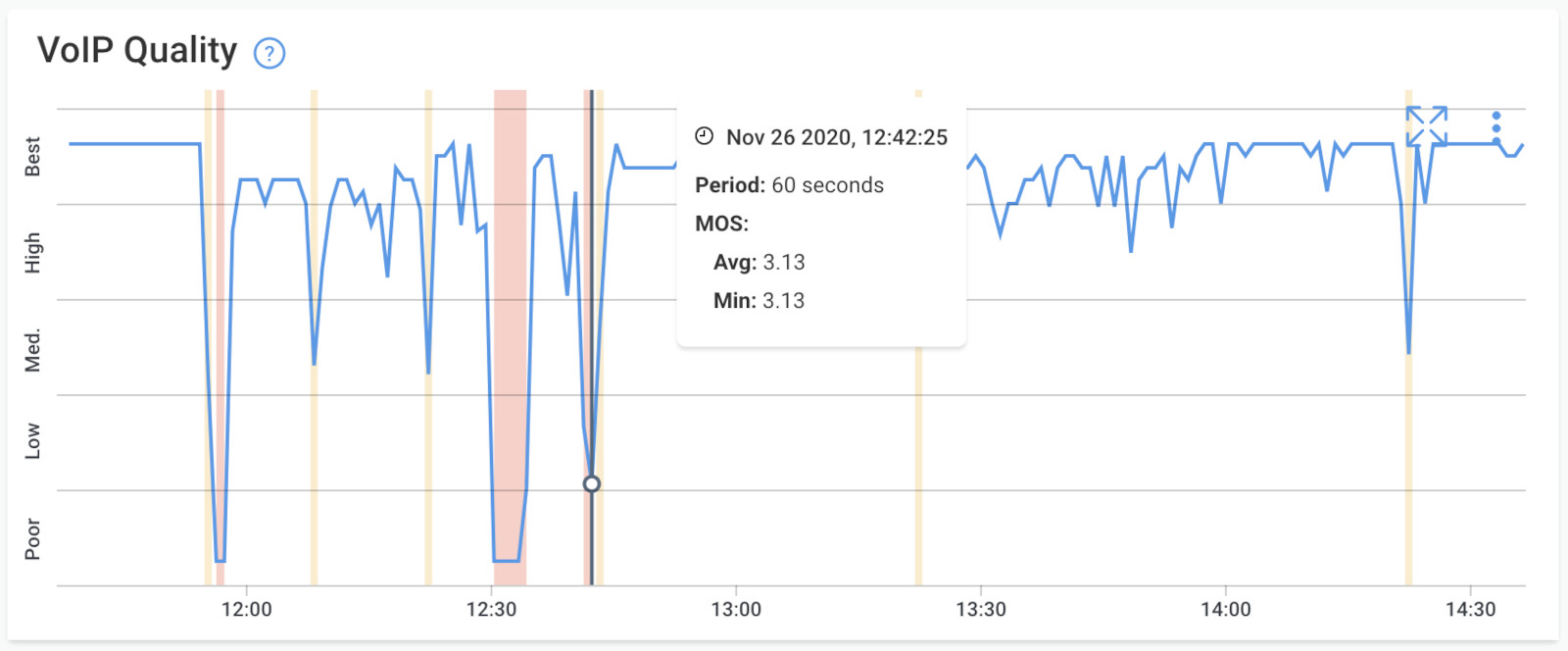
II. Video Streaming Testing:
Video streaming testing focuses on assessing the quality and uninterrupted playback of video content, such as videos on YouTube or video conferencing applications like Zoom. Here's what video streaming testing involves:
- Quality Assurance: Video streaming tests evaluate the video and audio quality, ensuring that videos play in high resolution with synchronized audio.
- Buffering and Playback Smoothness: These tests check for buffering issues and ensure that videos play without interruptions or stuttering.
- Load Handling: Video streaming testing can simulate heavy user loads to ensure that streaming servers and networks can handle peak video streaming demands without performance degradation.
- Content Delivery: For content delivery networks (CDNs), video streaming tests verify that video content is efficiently delivered to users from geographically distributed servers.
Both VoIP and video streaming testing are critical for ensuring a positive user experience in communication and media consumption. By conducting these tests, organizations can maintain clear voice calls and deliver smooth, high-quality video content to their users, contributing to customer satisfaction and effective communication.
I. Application-Specific Testing:
Customized synthetic tests are tailored to assess the performance of specific applications that are critical to your business operations. This approach involves simulating user interactions with these applications to evaluate their performance. Key aspects of application-specific testing include:
- Mimicking User Interactions: These tests replicate typical user actions within the application, such as data entry, transaction processing, or content retrieval. By mimicking these interactions, you can assess how well the application responds to user requests.
- Performance Assessment: Application-specific tests measure the responsiveness, speed, and reliability of the targeted application. This ensures that the application meets performance standards and user expectations.
- Identifying Bottlenecks: Customized tests help identify bottlenecks or areas where the application's performance may be compromised. This information can guide optimization efforts.
II. Load and Stress Testing:
Load and stress testing is a form of synthetic testing used to assess how well applications and infrastructure can handle heavy traffic loads and stressful conditions. This type of testing is essential to ensure that systems remain robust under peak usage scenarios. Key aspects of load and stress testing include:
- Simulating High Loads: Load tests simulate heavy user traffic to the application, often exceeding typical usage levels. This helps identify performance bottlenecks and assess the application's ability to scale.
- Stress Testing: Stress tests go a step further by pushing the system beyond its limits to determine when and how it may fail. These tests help uncover vulnerabilities and areas that need improvement.
- Capacity Planning: The data collected from load and stress tests informs capacity planning efforts, helping organizations allocate resources effectively to meet user demands without performance degradation.
- Failover Testing: In disaster recovery and business continuity planning, synthetic stress tests can assess how well network failover mechanisms work when primary systems experience high loads or failure.
Customized tests for specific applications and load/stress testing are vital for ensuring that critical business applications can perform reliably and efficiently, even during peak usage. By conducting these tests, organizations can address performance issues proactively, optimize infrastructure, and maintain a high-quality user experience.
Learn how to perform network testing using Network Monitoring tools to test network performance, and identify network bugs and issues.
Learn more

Synthetic testing is a powerful tool for assessing network performance, but the true value lies in the ability to interpret the results effectively. In this section, we dive into the art of deciphering synthetic test data, enabling network administrators and IT professionals to extract actionable insights.
Understanding key performance metrics, identifying common network issues, and exploring real-world examples of synthetic testing insights are at the core of this section. By mastering the art of interpretation, you'll be equipped to proactively address network challenges, optimize performance, and ensure a seamless user experience.
Join us as we unravel the mysteries of synthetic test results and unlock the potential to elevate your network's reliability and efficiency. Let's get started!
Interpreting synthetic test results begins with understanding key performance metrics. These metrics provide valuable insights into the health and performance of your network infrastructure.
We covered this earlier on in this article, but as a reminder, here are some of the essential metrics to focus on include:
- Latency: Latency measures the delay in data transmission and is critical for real-time applications like VoIP. High latency can indicate network congestion or other issues affecting responsiveness.
- Packet Loss: Packet loss measures the rate at which data packets fail to reach their destination. Excessive packet loss can lead to data retransmissions and degraded performance.
- Jitter: Jitter is the variation in packet arrival times. It can disrupt real-time communications like VoIP and video conferencing. Consistently low jitter is crucial for a smooth user experience.
- Throughput: Throughput measures the data transfer rate across the network. It's vital for assessing network capacity and ensuring that it meets application demands.
- DNS Resolution Time: This metric measures the time it takes for DNS queries to resolve. Quick DNS resolution is essential for fast web page loading.
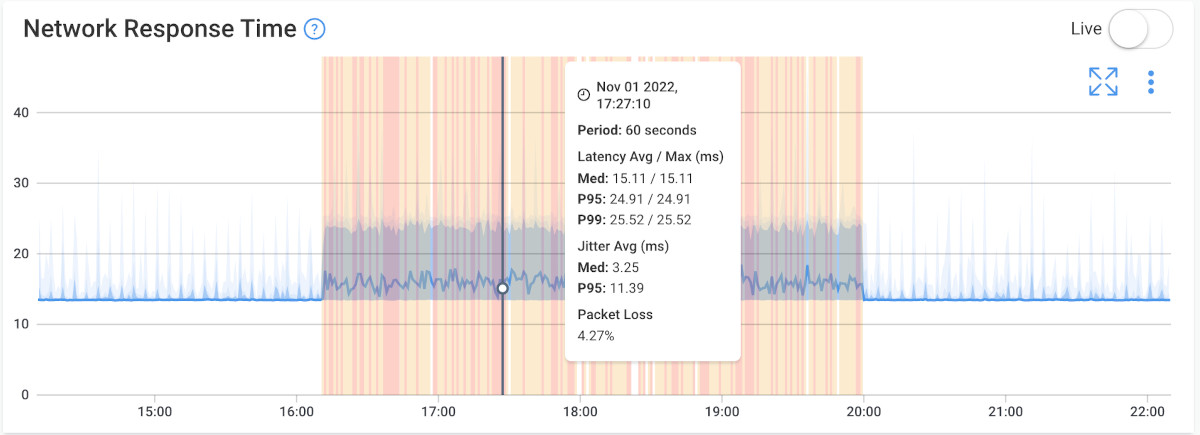
Interpreting synthetic test results involves identifying and troubleshooting common network issues that can impact performance and network reliability:
- Network Congestion: High latency, packet loss, and reduced throughput can be indicators of network congestion. This can occur when the network is handling more traffic than it can efficiently manage.
- Hardware or Software Problems: Consistent packet loss or high latency may suggest hardware or software issues with network devices, servers, or routers.
- Quality of Service (QoS) Issues: VoIP and video conferencing may suffer from poor quality if QoS settings are not properly configured to prioritize real-time traffic.
- DNS Problems: Slow DNS resolution times can result from DNS server issues or misconfigurations.
- Application Performance: Poor application performance, as indicated by HTTP or HTTPS tests, can result from server problems, inefficient coding, or inadequate server resources.
To emphasis the value of synthetic testing in networking, let’s take a look at these real-world examples of insights that can be gained:
1. Synthetic Testing for VoIP Performance:
Synthetic testing reveals that VoIP call quality degrades during specific times of the day due to network congestion. This insight prompts network administrators to optimize traffic management and QoS settings to ensure clear voice calls.
2. Synthetic Testing for E-commerce Websites:
Synthetic tests identify slow page load times and high latency during peak shopping hours. The e-commerce site addresses these issues by adding additional server capacity and optimizing content delivery.
3. Synthetic Testing for DNS Resolution:
Synthetic tests uncover inconsistent DNS resolution times, leading to the discovery of a misconfigured DNS server. Rectifying the configuration results in faster website access for users.
Interpreting synthetic test results empowers network administrators to proactively address issues, optimize performance, and enhance the overall user experience. By understanding these metrics and their implications, organizations can maintain a reliable and high-performing network infrastructure.
Staying ahead of network performance issues is one of the most important tasks of any network admin. This section delves into how synthetic testing serves as a linchpin for optimizing network performance, enabling proactive decision-making and seamless adaptation to dynamic network environments.
Discover the power of synthetic tests in capacity planning, preparing for network changes, and monitoring cloud-based services. With these insights, network administrators and IT professionals can fine-tune their networks, ensuring they are always ready to meet growing demands and adapt to evolving technology landscapes.
Capacity planning is a crucial aspect of network management, and synthetic tests play a pivotal role in this process:
- Traffic Simulation: Synthetic tests can simulate various levels of network traffic, helping organizations predict how their network will perform under different load conditions. This allows for proactive adjustments to accommodate increasing traffic demands.
- Resource Allocation:** By analyzing synthetic test results, network administrators can determine whether their current infrastructure can handle expected growth. They can allocate resources, such as bandwidth or server capacity, accordingly to ensure optimal performance.
- Cost Savings: Effective capacity planning helps organizations avoid overprovisioning, which can lead to unnecessary costs, or underprovisioning, which can result in performance bottlenecks. Synthetic testing ensures resources are allocated efficiently.
Networks are dynamic, with changes occurring regularly. Synthetic tests are instrumental in preparing for and adapting to these changes:
- Network Upgrades: Before implementing network upgrades, such as hardware changes or configuration modifications, synthetic tests can assess the impact on network performance. This prevents unforeseen issues and downtime.
- Software Updates: Synthetic tests can be used to test the compatibility of new software versions with existing network infrastructure. This ensures that software updates do not negatively affect performance.
- Security Changes: Network security updates, including firewall rules or intrusion detection systems, can be evaluated using synthetic tests to ensure they don't hinder network responsiveness.
With the increasing adoption of cloud-based services, synthetic tests are invaluable for monitoring the performance of these services and should be a part of any cloud network monitoring strategy.
- Cloud Service Assessment: Synthetic tests can evaluate the performance of cloud-based applications and services. This includes assessing the latency, reliability, and availability of services hosted in the cloud.
- Multi-Cloud Environments: Organizations utilizing multiple cloud providers can use synthetic tests to compare the performance of each provider, ensuring they choose the one that best meets their requirements.
- Hybrid Networks: In hybrid network setups, which combine on-premises infrastructure with cloud resources, synthetic tests ensure that the transition between on-premises and cloud-based services is seamless and optimized.
By incorporating synthetic tests into capacity planning, change preparation, and cloud service monitoring, organizations can optimize network performance, reduce operational risks, and provide a reliable and consistent user experience, even as their networks evolve and grow.


Troubleshooting network issues can be a complex and time-sensitive task. However, with the strategic use of synthetic testing, network admins and IT professionals gain a powerful tool for efficient problem-solving. In this section, we explore how synthetic tests serve as a compass in the labyrinth of network troubleshooting.
Discover the art of pinpointing network problems, resolving connectivity and latency issues, and improving application performance through the lens of synthetic testing. These tests provide real-time insights, enabling quick issue detection, data-driven analysis, and effective problem resolution.
Troubleshooting network issues can be a complex endeavor, but synthetic tests simplify the process by pinpointing problems efficiently:
- Isolating the Source: Synthetic tests help identify whether issues originate from within your network or external factors. By comparing internal and external tests, you can determine whether the problem lies with your infrastructure or external services.
- Proactive Issue Detection: Synthetic testing continuously monitors network performance, allowing you to detect problems as soon as they arise. This proactive approach minimizes downtime and ensures timely resolution.
- Data-Driven Insights: Synthetic test results provide valuable data and historical records, enabling administrators to analyze trends and patterns to identify recurring issues and their root causes.
Network connectivity issues and latency problems can disrupt network operations, but synthetic testing aids in their resolution:
- Connection Verification: Synthetic tests confirm whether network devices and services are accessible. If connectivity fails, tests can identify which part of the network is experiencing issues.
- Latency Reduction: By measuring latency with synthetic tests, administrators can identify high-latency segments and take corrective actions. This may involve optimizing network paths, adjusting routing, or addressing congestion.
- Quality of Service (QoS) Optimization: Synthetic tests can assess the effectiveness of QoS settings and ensure that critical traffic, like VoIP, receives the necessary priority for low-latency communication.
Application performance is paramount for user satisfaction, and synthetic tests play a key role in enhancing it:
- User Experience Enhancement: Synthetic tests simulate user interactions with applications, such as web browsing or database access, to evaluate performance from an end-user perspective. Slow application response times or errors can be identified and addressed.
- Load Balancing: Synthetic testing helps fine-tune load balancing configurations to ensure even distribution of traffic among servers. This improves application scalability and prevents server overload.
- Database Performance: For applications reliant on databases, synthetic tests can gauge the efficiency of data retrieval and transactions, aiding in database optimization.
Incorporating synthetic testing into network troubleshooting efforts equips network administrators and IT professionals with the tools needed to swiftly identify, address, and prevent connectivity, latency, and application performance issues. By doing so, organizations can maintain a stable, responsive, and reliable network environment.
Learn how to troubleshoot network issues by identifying where, what, why network problems occur with Network Troubleshooting tools.
Learn more

Throughout this article, we’ve discussed how Synthetic Testing (or Synthetic Network Testing) has evolved as a modern, proactive approach to monitoring and improving network performance and reliability. However, realizing the full potential of synthetic testing demands the application of best practices that guide its strategic implementation and integration into IT workflows.
This section is your guide to the art and science of synthetic testing best practices. Join us as we explore the fundamental principles that elevate synthetic testing from a diagnostic tool to a proactive force for network excellence.
A robust testing strategy is the cornerstone of effective synthetic testing. In this section, we delve into the importance of diverse test scenarios, regular testing schedules, and the importance of aligning tests with your organization's specific objectives. By establishing a strong testing strategy, you lay the groundwork for comprehensive network performance monitoring.
- Diverse Test Scenarios: Implement a range of synthetic tests to cover different aspects of network performance, from basic connectivity checks to application-specific tests. Ensure that tests align with your organization's specific goals and priorities.
- Regular Testing: Establish a regular synthetic testing schedule to continuously monitor network performance. Regularity helps identify issues promptly and track changes in performance over time. Synthetic Network Monitoring tools like Obkio continuously monitor network performance with automated synthetic traffic, so you don’t need to worry about setting any schedules.
- Realistic Test Conditions: Mimic real-world user interactions as closely as possible in synthetic tests. This ensures that the insights gained accurately reflect the user experience.
Efficiently integrating synthetic testing into your IT workflows is essential for maximizing its benefits. We explore the advantages of automation, alerting mechanisms, and integration with existing monitoring tools. This seamless integration ensures that synthetic testing becomes an integral part of your network management practices.
- Automation: Automate the execution of synthetic tests to reduce manual effort and enable continuous monitoring. This ensures that tests run consistently and provide timely data. As mentioned earlier, Synthetic Network Monitoring tools like Obkio continuously monitor network performance so you don’t need to worry about automating it yourself.
- Alerting Mechanisms: Set up alerting mechanisms to notify IT teams when test results deviate from predefined thresholds. Alerts enable rapid response to performance issues.
- Integration with Monitoring Tools: Integrate synthetic testing data into existing network monitoring and management tools to centralize insights and streamline troubleshooting. Some tools, like Obkio, are already Synthetic Monitoring tools. So if you’re looking to use this technique, opt for an existing Synthetic Monitoring tool instead of traditional packet capture, passive monitoring solutions.
Networks are dynamic, and synthetic testing should be adaptable. Here, we discuss the importance of scalability, flexible testing configurations, and regular strategy reviews. These practices empower your organization to stay agile and responsive in the face of evolving network conditions and technological advancements.
- Scalability: Ensure that your synthetic testing infrastructure can scale to accommodate network growth. Scalable testing solutions allow you to maintain comprehensive coverage as your network expands.
- Flexible Testing Configurations: Be prepared to adjust test parameters and configurations in response to network changes or evolving requirements. Flexibility ensures that tests remain relevant and effective.
- Regular Review: Periodically review and update your synthetic testing strategy to align with evolving business goals and technological advancements. This ensures that testing efforts remain focused and meaningful.
By following these synthetic testing best practices, organizations can establish a robust testing strategy, seamlessly integrate testing into their workflows, and stay agile in adapting to ever-changing network environments. The result is a proactive and effective approach to network performance monitoring and optimization.
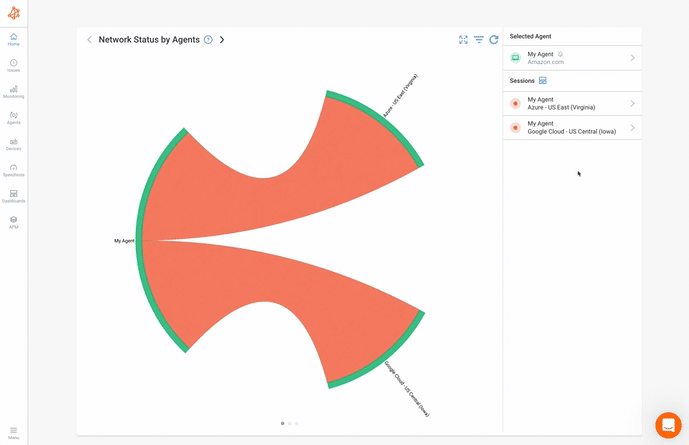
In conclusion, the power of synthetic testing in networking (synthetic network testing) cannot be overstated. It serves as a critical tool for gaining insights into network performance, proactively addressing issues, and ensuring a seamless user experience. Synthetic tests simulate real-world interactions and provide a comprehensive view of your network, enabling you to identify and resolve problems before they impact users.
By measuring key performance metrics, such as latency, packet loss, and throughput, synthetic testing empowers network administrators and IT professionals to make informed decisions, optimize resources, and maintain a high-performing network infrastructure.
To harness the full potential of synthetic testing, consider utilizing Obkio’s Synthetic Monitoring tool. With Obkio, you can take control of your network performance like never before. This cloud-based solution simplifies the deployment and management of synthetic tests, allowing you to monitor network performance across various locations and gain valuable insights from a centralized dashboard.

Whether you're ensuring the reliability of critical applications, preparing for network changes, or troubleshooting connectivity issues, Obkio’s Synthetic Monitoring tool equips you with the data and tools needed to maintain a robust and efficient network environment.
In a world where network performance is synonymous with productivity and user satisfaction, Obkio’s Synthetic Monitoring tool empowers you to stay ahead of the curve, providing a competitive edge and peace of mind in the realm of network management.
Incorporate synthetic testing into your network management strategy, and with Obkio as your ally, you'll be primed to optimize network performance, proactively resolve issues, and deliver an exceptional user experience. It's time to take control of your network's destiny, and the journey begins with synthetic testing and Obkio.



























 Obkio Blog
Obkio Blog









